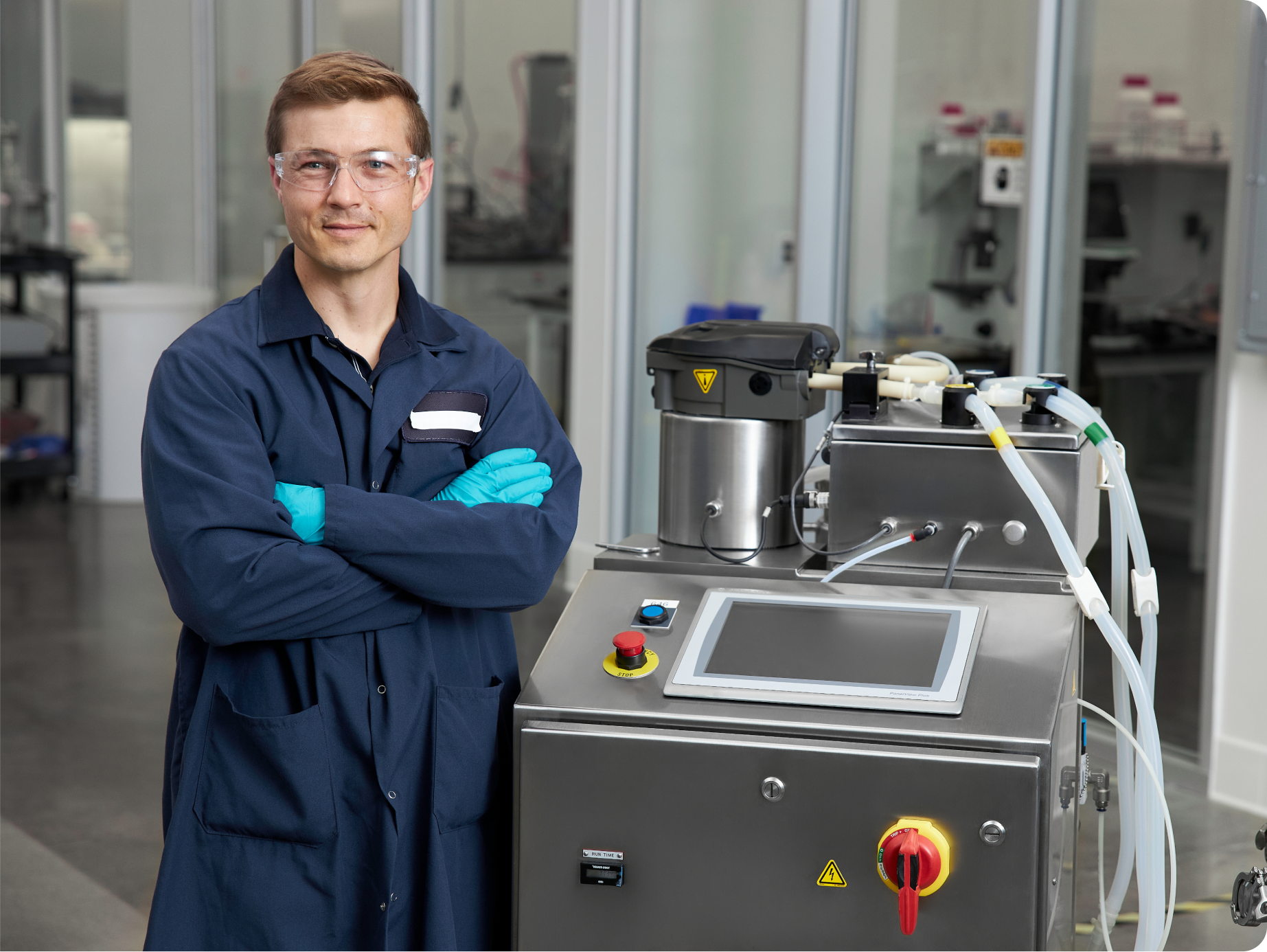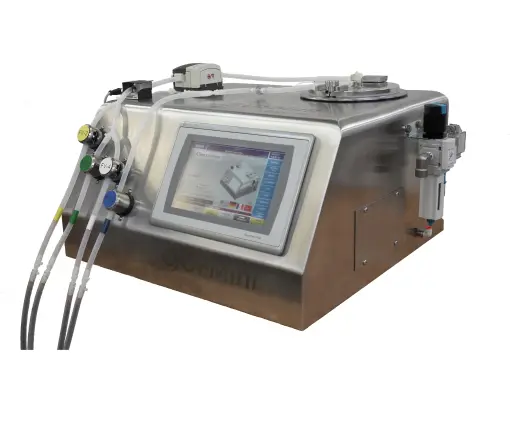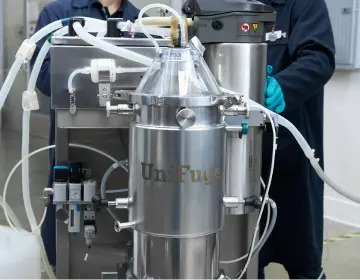Why traditional harvest methods fall short in allogeneic manufacturing
Despite advances in cell culture and upstream process control, cell harvesting remains a point of vulnerability in many allogeneic manufacturing workflows. Traditional centrifugation approaches are limited in scalability, require long processing times, and often introduce mechanical stress that compromises viability—especially for fragile cell types like iPSCs, T cells, NK cells, and MSCs. High cell loss, long processing times, and uncontrolled shear can reduce the functional quality of the final product or force conservative process parameters that limit efficient manufacturing at scale.
Open or manual harvest methods introduce another layer of risk. In addition to low throughput, transfers between vessels, reliance on biosafety cabinets, and operator-dependent protocols increase the chance of contamination and batch failure. These approaches also complicate batch record-keeping and strain cleanroom resources, making them poorly suited for commercial-scale production.
As allogeneic therapies move toward higher batch volumes and stricter quality requirements, these legacy methods become increasingly difficult to justify. The industry needs harvest solutions that protect cell quality, reduce handling, and align with GMP expectations—without sacrificing scalability or process efficiency.
Designing for high recovery without compromising cell function
Cell recovery is only meaningful if it preserves function. In allogeneic manufacturing, this means maximizing yield without compromising cell health. Achieving this balance requires tight control over the environment cells experience during separation.
- G-forces and flow rates: Reduce shear and preserve cells: Operating at moderate G-forces and controlled flow rates helps limit mechanical stress during separation. These conditions reduce shear and turbulence, which in turn minimizes membrane damage and loss of viability—especially for sensitive immune and stem cell populations.
- Automation: Reduce variability and handling risk: Automated systems provide precise, recipe-driven control of flow, speed, and phase transitions (feed, wash, concentrate). This reduces operator variability and enhances reproducibility across batches, supporting smoother tech transfer from development to commercial scale. Integrated wash steps enable gentle in-situ buffer exchange, eliminating secondary transfers that can introduce stress or product loss.
Systems that combine low-shear operation with automation, such as the UniFuge® platform, routinely achieve greater than 90% cell recovery and less than 5% viability loss across a variety of allogeneic cell types. This level of performance minimizes variability during downstream formulation and fill/finish, helping preserve product quality.
How to scale harvest operations without sacrificing performance
Cell harvesting processes must scale reliably for allogeneic therapies to succeed commercially, maintaining performance without introducing variability or risk.
Technical continuity: Many traditional centrifuge systems behave differently at the production scale than at the bench, creating performance gaps and forcing revalidation. Systems designed with consistent mechanics and control logic across scales simplify tech transfer and ensure reproducibility.
Key characteristics of a technically scalable system:
- Consistent mechanical principles across development and production platforms
- Predictable separation behavior from lab to commercial scale
- Compatible control systems for recipe transfer and automation logic
- Volume flexibility, e.g.:
- UFMicro®: 0.1-5L
- UFMini®: 1–5L
- Unifuge Pilot®: 25–200L
Risk mitigation: Scaling up isn’t just about volume—it’s also about reducing process risk. Manual systems often increase validation complexity and slow changeover—particularly in multi-product or high-throughput environments. Closed, single-use systems can streamline operations and support compliance.
Benefits of closed, single-use harvest platforms:
- Reduced contamination risk across batches and products
- Lower operator burden and reduced time-in-suite
- Simplified compliance with cGMP and aseptic processing standards
Real-world applications where smarter harvest drives better outcomes
Optimized cell harvesting is not a standalone improvement—it directly affects the success of downstream steps. In allogeneic workflows, several critical applications depend on recovering concentrated, high-viability cells at the right time and in the right format.
Preparation for cryopreservation
Cryopreserved allogeneic therapies require high-density cell suspensions with minimal residual media. Harvest systems that can concentrate cells to 20–200 million cells/mL and reduce final discharge volumes to as little as 100 mL support efficient cryo workflows without dilution or additional processing steps.
Why it matters:
- Achieves target cell concentrations for downstream processing
- Enables direct integration with fill/finish
- Improves post-thaw viability
Upstream to downstream transition
Harvested cells often move directly into gene editing, transfection, or formulation. In-situ buffer exchange replaces spent media—often containing serum, cytokines, or inhibitory compounds—with clean buffers or formulation-grade solutions to prepare for the next step.
Why it matters:
- Removes residual components that interfere with downstream processing
- Preserves viability and functional performance
- Enables closed, efficient handoff to next unit operation
Consolidating harvest, wash, and final formulation into a single closed system reduces equipment handoffs and validation steps.
Key questions to identify gaps—and opportunities—in your harvest workflow
Even small inefficiencies in cell harvesting can ripple through an allogeneic manufacturing workflow—affecting yield, cost, and product quality. For teams looking to improve or scale their process, a few key questions can help identify where the greatest impact can be made:
- What are my current recovery losses?
Even modest improvements in recovery can significantly increase batch yield and reduce the cost of goods. - Can my process perform in-situ washes, or is it dependent on manual transfers?
Eliminating open steps improves consistency, reduces contamination risk, and saves time. - Is my harvest method scalable, closed, and optimized for GMP use?
If not, tech transfer and commercial readiness may be more fragile than they appear.
Answering these questions often reveals opportunities to de-risk and streamline one of the most consequential steps in allogeneic manufacturing.
Start with the right system. Build for what comes next.
As therapies scale and timelines compress, the systems behind them must be equally adaptable. The most resilient manufacturing strategies begin with thoughtful, flexible choices at the foundation.
Learn more about how UniFuge® supports next-generation cell processing.





